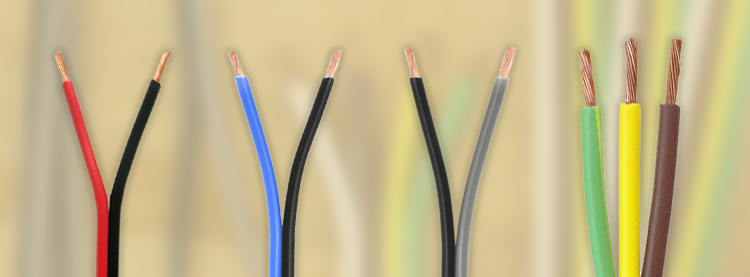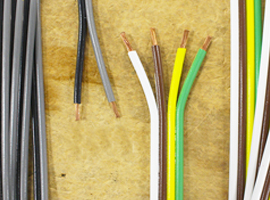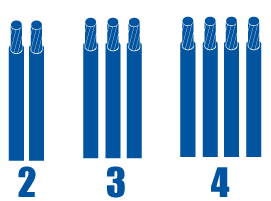Categories
- Wire & Cable
- Multi-conductor & Signal Cable
- Battery Cable Assemblies
- Terminals and Connectors
- Electrical Parts
- Electrical Tools
- ID Products
- Wire Management
- Tape & Sealant
- Mounting Panels & Panel Blanks

Need Help?
Click HereGet a Business Account
Apply HereZip Cord

What is Zip Cord?
Zip cord is an electrical wire notable for having two or more conductors that are parallel bonded. Their insulated jackets can be easily separated from one another by being pulled apart. This cable is an economical alternative to jacketed cable. It is ideal for low-voltage lights, trailer lights, and DC circuits. Commonly, this type of wire is used where multiple conductors need to be routed quickly. How many conductors are available? Well, zip cord is made of two, three, or four conductors of various colors parallel bonded.
Pacer zip cord is constructed from 105°C annealed bare copper primary wire (Type II). The insulation is color-coded for easy identification. What colors are available? That depends on the number of conductors you need. If you're looking for two conductors, one of the two will always be black. The other wire can be red, blue, dark blue, yellow, or grey. If you are looking at three or four conductors, then the first three will be brown, yellow, and green. On a four-conductor zip cord, the fourth wire is white. Pacer offers a variety of zip cord color combinations.
"This cable is an economical alternative to jacketed cable. It is ideal for low-voltage lights, trailer lights, and DC circuits."
How do I properly strip zip cord wire?
If you’re stripping zip cord, also known as bonded wire, make sure that you have the proper cable cutter and compact wire stripper. The first step is to measure the cord to the correct length, making sure to add at least an extra inch or so. Use the cable cutters to cleanly slice through the zip cord in one clean motion. With your zip cord cut, you’ll need to pull the conductors apart so they can be stripped. After you determine the correct amount of insulation to strip, use the compact wire stripper to cut into the insulation. Pull the tool away from the wire to remove the cut piece. Now you just need to repeat the process on the remaining wires.
Where is zip cord implemented?

Zip cord is also known as bonded cord.
Pacer's zip cord is implemented in everything from marine vessels to vehicle trailers. Ideal for new wire runs or replacing older wire runs. How do you know if you need to replace your zip cord?
Start by examining the insulation. Does your zip cord have faded insulation or cracked wire insulation? If so, it may be time to replace it. All you will need are the proper cutting tools, the proper stripping tools, and the correct connectors.
Where would you use zip cord?
Zip cord is known for its flexibility and ease of installation. It is an obvious choice in places such as trailer lights, DC circuits, and low-voltage lights. Commonly, this type of wire is used where multiple conductors need to be routed quickly. You will find zip cords in a wide range of locations, although most people would likely recognize them from connecting their trailer lights to their boat or car. You will also commonly find them in DC circuits where multiple wires need to run to a singular location or a few locations in close proximity to one another.
![]()
Trailer Lights
![]()
DC Circuits
![]()
Low Voltage Lights
How many conductors are available?

Zip cord is made of two, three, or four conductors of various insulation colors that have been parallel bonded. In this way, you can get the exact number of conductors you need to fit the job at hand. Why struggle with too few or too many conductors when you can get the amount you need? We currently offer 14 AWG in two-conductor only, while we offer the 16 AWG in two-conductor, three-conductor, and four-conductor.
Is it possible to separate the conductors?
Yes, it is possible to separate the conductors, and in fact, it is part of the design of the cable itself. Zip cord is made in such a way that each wire will stay connected until you decide to separate them. This means that whether you decide to separate them or not, you have not compromised the integrity of the wire on any level. In fact, separating the wires is a simple task that requires no tools, knowledge, or special equipment. All you need to do is grab the two wires you wish to separate and pull them apart starting at the tip. This action causes the connective material to separate which, again, does not adversely affect the integrity of the wires.

What colors of insulation are available?
The color of the insulation is dependent on the size of the wire itself. When it comes to 14 AWG wire, the available colors are black and red, black and grey, and black and blue. When it comes to 16 AWG wires, the available colors for two-conductor are black and red, black and grey, black and dark blue, black and yellow, and black and pink. For three-conductor zip cord, the available colors are brown, yellow, and green with a yellow stripe. For four-conductor, the available colors are brown, yellow, green with a yellow stripe, and white.

What advantages does zip cord offer?
Zip cord offers a range of advantages, such as flexibility, durability, and the ability to be routed quickly and easily through tight spaces. Another advantage is the fact that zip cord can be easily and quickly separated into individual ends. Zip cord also comes in a range of gauge sizes, insulation colors, and the number of conductors.
![]()
Durable
![]()
Flexible
![]()
Routable
What are some features of zip cord?

Zip cord has a range of features, some of which we have already discussed. It is made from annealed stranded copper, which gives it durability and flexibility, both of which are extremely important features to have. Additionally, zip cord is rated for 60 volts and can handle temperatures ranging between -20°C to 105°C. Another feature, which is a bit obvious, is the color-coded insulation. It is easy to see why zip cord is the preferred choice of many industries. Let's go ahead and look at what industries use zip cord.
Which industries use zip cord?
Zip cord is used in a wide range of industries and applications, such as automotive, robotics, remote control operations, requirement-specific radio applications, and recreational vehicles. This shows how versatile zip cord can be. With its flexibility, durability, ease of installation, and variety of conductors, gauge sizes, and insulation colors, it's no surprise that this type of wire is so universally accepted. Have a question about zip cord? Choosing the right type of zip cord for your project is not always an easy task. Contact a Pacer expert today with any questions that you may have.
![]()
Automotive
![]()
RV
![]()
Radio
![]()
RC
![]()
Robotics
*This page was updated on 1/30/2025*


